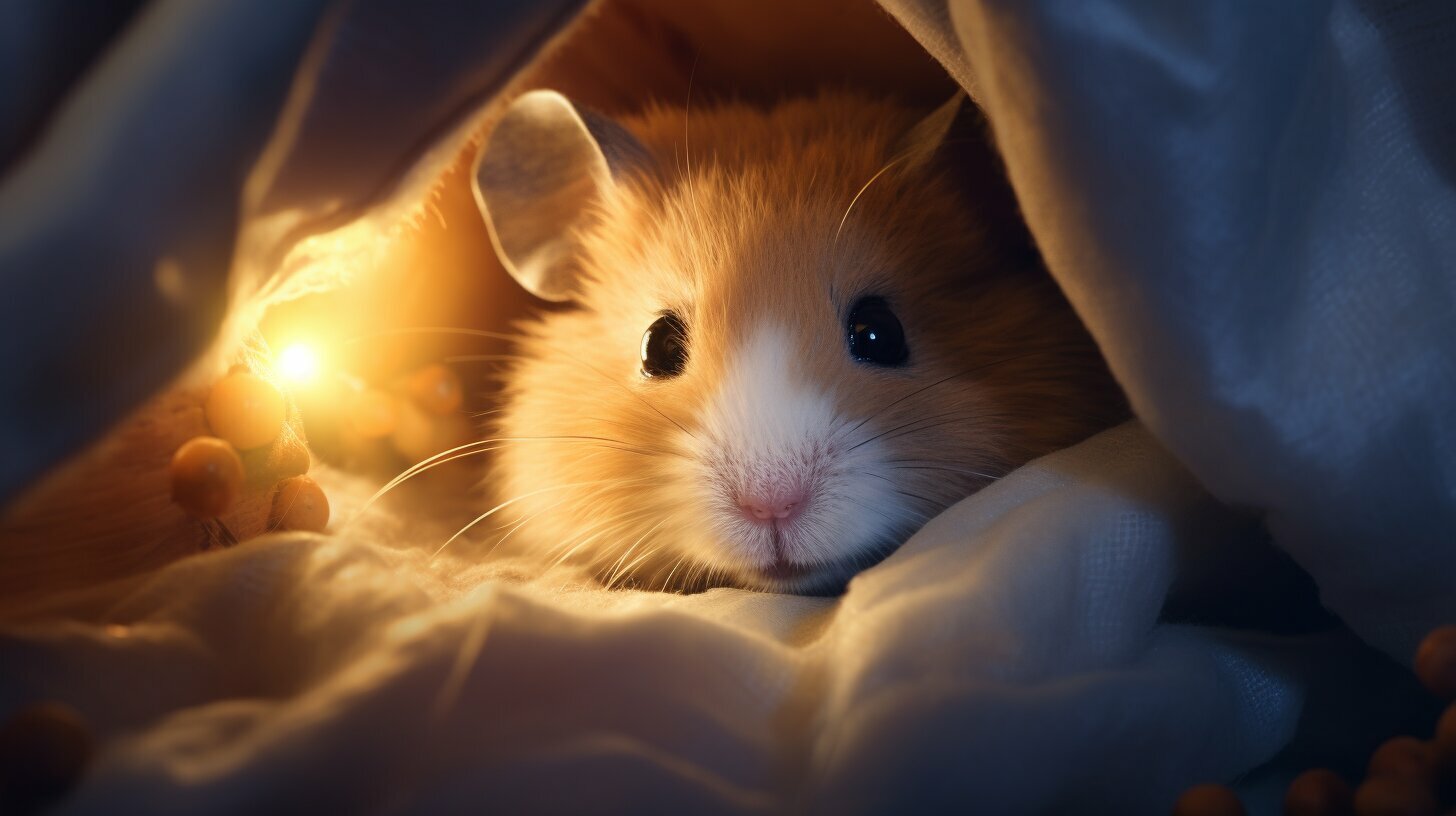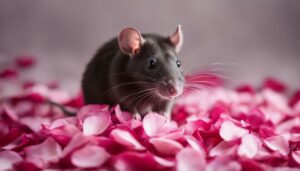Hamsters are fascinating creatures that often evoke curiosity about their living preferences, including their affinity for darkness. These nocturnal creatures have evolved to have a sleep schedule that aligns with the darkness of night, making them feel safe and secure. While hamsters do need a balance of light during the day and darkness at night to thrive, they do not require a light at night. In fact, excessive light exposure can disrupt their circadian rhythm and prevent them from sleeping properly. So, it’s best to provide a dark environment for your hamster to ensure their well-being.
Key Takeaways:
- Hamsters are naturally nocturnal animals and prefer to be in the dark during their active hours.
- Darkness makes hamsters feel safe and secure, mimicking their natural habitat conditions.
- Excessive light exposure can disrupt hamsters’ sleep patterns and overall well-being.
- It is best to let natural moonlight enter the room or use low light sources, such as a nightstand lamp or red light, to interact with your hamster at night.
- Maintaining a natural light and dark cycle for hamsters is crucial for their overall health and happiness.
The Nocturnal Nature of Hamsters
Hamsters are nocturnal creatures, which means they are most active during the night and prefer to sleep during the day. This behavior is deeply rooted in their evolutionary history and natural instincts. In the wild, hamsters seek shelter in the darkness of tunnels and burrows to stay safe from predators. It is in the cover of darkness that they feel most secure, allowing them to engage in their natural nocturnal activities.
Understanding the sleep patterns of hamsters is key to providing them with a suitable habitat. These small rodents typically sleep for around 14-16 hours a day, with the majority of their sleep occurring during the day. They have a unique sleep cycle, consisting of multiple short bouts of sleep punctuated by periods of wakefulness. This cycle aligns with their preference for darkness, as they are most active during the night when the environment is naturally dim.
To ensure the well-being of your hamster, it is important to create a conducive sleep environment. Excessive light exposure during their active hours in the dark can disrupt their circadian rhythm and interfere with their sleep. It is best to provide a natural light and dark cycle, allowing them to experience the dimness of nighttime. If you need to interact with your hamster at night, consider using low light sources such as a nightstand lamp or red light, as these options minimize disturbance and preserve their natural sleep patterns.
| Hamster Behavior in the Dark |
|---|
| Hamsters are most active during the night. |
| They prefer to sleep during the day. |
| Hamsters feel safe and secure in the darkness. |
| Excessive light exposure disrupts their sleep patterns. |
Understanding Hamster Sleep Cycles
Hamsters have unique sleep patterns that are closely tied to the darkness of their surroundings, necessitating a suitable environment for restful sleep. These nocturnal creatures are designed to be active during the nighttime when it is dark, as this is when they feel most secure and safe from potential predators. As a hamster owner, it is important to understand their natural sleep cycles to provide them with the optimal conditions for sleep and overall well-being.
Hamsters typically sleep during the day and are most active at night. Their sleep patterns can be described as polyphasic, meaning they have multiple sleep periods throughout a 24-hour cycle. These sleep periods last anywhere from a few minutes to a few hours, and during these times, hamsters prefer to be in a dark environment.
To ensure that your hamster gets the quality sleep it needs, it is essential to create a suitable sleeping environment. This includes providing a cozy and secure nesting area within their cage, away from any sources of light or disturbance. Avoid placing bright lights near their cage during their sleep hours, as this can disrupt their sleep cycles and lead to sleep deprivation.
Instead, it is best to let natural moonlight enter the room or use low light sources, such as a nightstand lamp or red light, to see and interact with your hamster at night. These low light options will allow you to observe your furry friend without disturbing their sleep or compromising their natural sleep-wake cycle. By maintaining a balanced light and dark cycle, you can support your hamster’s overall well-being and ensure they get the restful sleep they need.
| Key Points: |
|---|
| Hamsters have unique sleep patterns tied to darkness. |
| They are most active at night when it is dark. |
| Create a suitable sleeping environment with minimal light. |
| Avoid bright lights during their sleep hours. |
| Use low light, such as a nightstand lamp or red light, for nighttime interactions. |
Hamsters’ Need for Darkness
Darkness is an essential element for hamsters as it replicates their natural habitat, providing them with a sense of security and comfort. Being nocturnal creatures, hamsters have evolved to have a sleep schedule that aligns with the darkness of night, making it their preferred time for activity. When hamsters are in the dark, they feel safe from potential predators and can engage in their natural behaviors without disturbance.
While hamsters do need a balance of light during the day and darkness at night to thrive, they do not require a light source at night. In fact, exposing them to bright lights in the nighttime can disrupt their circadian rhythm and prevent them from getting proper restful sleep. It is important to remember that hamsters are naturally adapted to low light conditions, and excessively bright lights can cause stress and behavioral issues.
To interact with your hamster during their active hours in the dark, it is best to use low light sources. Natural moonlight entering the room is often sufficient for them to navigate their surroundings comfortably. Alternatively, you can use a nightstand lamp or a red light, as these provide enough illumination for you to see and interact with your hamster without disturbing their sleep cycles.
The Benefits of a Dark Environment for Hamsters
A dark environment not only makes hamsters feel secure, but it also promotes their overall well-being. In darkness, hamsters are able to engage in natural behaviors such as burrowing, exploring, and foraging. It allows them to feel more relaxed and less exposed, which can lead to reduced stress levels and a happier, healthier pet. By providing a suitable and natural sleeping environment for your hamster, you are ensuring that they can establish a regular sleep routine and enjoy optimal restful sleep.
To create the optimal environment for your hamster, consider factors such as cage placement and natural lighting. Place their cage in a quiet area away from direct sunlight and excessive artificial light. Providing hiding spots, such as tunnels or houses, can also contribute to their sense of security during their active hours in the dark. Remember, maintaining a natural light and dark cycle is crucial for the well-being of your hamster.
| Benefits of a Dark Environment for Hamsters: |
|---|
| Replicates their natural habitat |
| Provides a sense of security and comfort |
| Promotes natural behaviors and reduces stress |
| Allows for optimal restful sleep |
The Role of Light in Hamster Well-being
While darkness is vital for hamsters, it is equally important to understand their sensitivity to light and the potential negative effects of excessive exposure. Hamsters, being nocturnal creatures, have evolved to thrive in darkness, as it mimics their natural habitat conditions and makes them feel safe and secure. Striking a balance between light and darkness is crucial for their overall well-being.
Excessive exposure to light can disrupt hamsters’ circadian rhythm, the internal clock that regulates their sleep-wake cycle. Bright lights during the nighttime can confuse their natural sleep patterns and prevent them from getting the restful sleep they need. It is best to allow natural moonlight to enter the room or use low light sources, such as a nightstand lamp or red light, to ensure minimal disruption while interacting with your hamster at night.
Hamsters are known for their sensitivity to light, and prolonged exposure to bright light can cause stress and discomfort. Scientific research has shown that excessive light can lead to changes in their behavior, such as increased aggression and reduced activity levels. Creating a dark and calm environment during their active hours is essential to promoting their natural behavior and allowing them to thrive.
By respecting their natural nocturnal behavior and providing a suitable environment with the right balance of light and darkness, you can ensure the well-being of your hamster. Remember to keep their sleep cycles in mind and avoid exposing them to excessive light at night. With the right care and environment, your hamster can enjoy restful sleep and lead a healthy and happy life.
Creating the Optimal Environment
To ensure the well-being of your hamster, it is crucial to create an environment that aligns with their habitat preferences, including providing the right amount of darkness. Hamsters are naturally nocturnal creatures, meaning they are most active during the night and prefer a dark environment to feel safe and secure.
When setting up your hamster’s habitat, consider the placement of their cage. Choose a location away from direct sunlight or bright artificial lights that might disturb their sleep. Additionally, avoid placing their cage in high traffic areas or near loud noises, as hamsters are sensitive to disruptions during their restful sleep.
Providing natural lighting during the day and darkness during the night is essential for maintaining a healthy light and dark cycle for your hamster. While hamsters do not require a light source at night, it can be helpful to have a dim light, such as a nightstand lamp or a red light, to navigate the room and interact with your pet without disturbing their sleep patterns.
Remember, it’s important to strike a balance between light and darkness to ensure the well-being of your hamster. By creating an optimal environment that considers their habitat preferences, you can help them feel comfortable, secure, and well-rested.
| Key Points |
|---|
| Hamsters are naturally nocturnal and prefer a dark environment. |
| Place the hamster cage away from direct sunlight and bright artificial lights. |
| Avoid high traffic and noisy areas that may disrupt their sleep. |
| Provide a natural light and dark cycle by allowing natural light during the day and darkness at night. |
| Use low light sources, like a nightstand lamp or a red light, for nighttime interaction. |
Balancing Natural and Artificial Light
Achieving a balance between natural and artificial light is key to providing an optimal environment for hamsters, keeping their well-being in mind. Hamsters are naturally nocturnal creatures, and darkness plays a crucial role in their sleep patterns and overall health. While they do require some light during the day, excessive light exposure at night can disrupt their circadian rhythm and prevent them from getting the restful sleep they need.
To accommodate their preference for darkness, it is best to let natural moonlight enter the room where your hamster is housed. If additional light is necessary for you to see and interact with your pet at night, opt for low light sources such as a nightstand lamp or a red light. These dim lighting options help maintain the dark environment while allowing you to observe and engage with your hamster without disturbing their sleep.
Creating a suitable habitat for your hamster involves more than just the light source. Consider the placement of their cage to ensure they have a quiet and undisturbed area. Avoid exposing their enclosure to direct sunlight or bright artificial lighting during the day, as this can cause stress and discomfort. Additionally, provide hiding places inside their cage where they can retreat and feel safe, as darkness allows them to mimic their natural habitat conditions.
| Key Points: |
|---|
| Hamsters prefer darkness due to their nocturnal nature. |
| Excessive light exposure at night can disrupt their sleep patterns. |
| Use low light sources, such as a nightstand lamp or red light, when interacting with your hamster at night. |
| Avoid exposing their cage to direct sunlight or bright artificial lighting. |
| Provide hiding places in their cage to mimic a natural, dark habitat. |
Interacting with your Hamster at Night
Interacting with your hamster during their active hours at night requires careful consideration to avoid disturbing their natural behavior and sleep patterns. Hamsters are nocturnal creatures and prefer to be in the dark, as this aligns with their natural sleep schedule and makes them feel safe and secure.
While it’s important to provide a suitable environment for your hamster to thrive, it’s equally important to respect their need for darkness. Excessive light exposure at night can disrupt their circadian rhythm and prevent them from getting the restful sleep they need.
When interacting with your hamster at night, it’s best to use low light sources. Natural moonlight entering the room or a nightstand lamp with a soft glow can provide enough illumination for you to see and interact with your hamster without disturbing their sleep. Alternatively, using a red light is also a great option as it does not affect their sleep patterns.
Remember that maintaining a balanced light and dark cycle is crucial for your hamster’s overall well-being. By ensuring that they have a dark environment to sleep in at night, you are helping them maintain their natural behavior and sleep patterns, ultimately promoting their health and happiness.
| Interacting with your Hamster at Night – Tips |
|---|
| Use low light sources such as natural moonlight or a nightstand lamp with a soft glow. |
| Consider using a red light, as it does not disrupt your hamster’s sleep patterns. |
| Avoid bright lights near their cage at night, as it can disturb their circadian rhythm. |
| Respect their need for darkness to ensure they get the restful sleep they need. |
The Importance of Restful Sleep for Hamsters
Providing a dark and tranquil environment is crucial for hamsters to achieve the restful sleep they need to maintain their health and well-being. Hamsters are naturally nocturnal animals, meaning they are most active during the night and sleep during the day. Their sleep patterns align with the darkness of their habitat, as it mimics their natural environment and makes them feel safe and secure.
Hamsters have evolved to have a circadian rhythm that is synchronized with the light and dark cycles. Excessive exposure to light during their active hours can disrupt their sleep and lead to stress and sleep deprivation. Therefore, it is important to create a suitable sleeping environment by keeping their cage in a dark and quiet area of the house.
While some hamster owners may feel tempted to provide a light source in the cage at night, it is best to avoid doing so. Bright lights can interfere with the hamster’s natural sleep patterns and prevent them from getting the rest they need. Instead, opt for using natural moonlight or low light sources, such as a nightstand lamp or a red light, to see and interact with your hamster without disturbing their sleep.
| Key Points: |
|---|
| Hamsters need a dark and tranquil environment for restful sleep. |
| Excessive light exposure can disrupt their sleep patterns. |
| Use natural moonlight or low light sources for nighttime interactions. |
Maintaining a natural light and dark cycle is essential for hamsters’ overall well-being. It helps regulate their sleep patterns, reduces stress, and allows them to engage in their natural behaviors. By providing a dark and quiet sleeping environment, you are ensuring that your hamster gets the restful sleep they need to stay healthy and thrive.
Conclusion
In conclusion, hamsters have a natural affinity for darkness due to their nocturnal nature, and creating an environment that respects their need for a dark and tranquil space is essential for their overall health and happiness.
Factual data supports the preference of hamsters for darkness. These small creatures have evolved to follow a sleep schedule that aligns with the darkness of night, ensuring they feel safe and secure from potential predators. While it is important for hamsters to have a balance of light during the day, they do not require a light source at night. In fact, exposing them to bright lights during their active hours can disrupt their circadian rhythm and interfere with their ability to sleep properly.
Instead, it is best to allow natural moonlight to enter the room or use low light sources, such as a nightstand lamp or red light, when interacting with your hamster at night. By maintaining a natural light and dark cycle, you can ensure the well-being of your furry friend.
Providing a dark and tranquil space for your hamster to rest and sleep is crucial for their overall health. This environment mimics their natural habitat conditions and allows them to engage in important sleep cycles essential for their physical and mental well-being. By respecting their natural nocturnal behavior and offering them the darkness they crave, you can contribute to their happiness and help them thrive.
FAQ
Q: Do hamsters like to be in the dark?
A: Yes, hamsters prefer to be in the dark. They are naturally nocturnal creatures and feel safe and secure in darkness.
Q: Why are hamsters nocturnal?
A: Hamsters are nocturnal because they evolved to have a sleep schedule that aligns with the darkness of night, which helps them avoid predators.
Q: Do hamsters need light at night?
A: Hamsters do not require light at night. In fact, bright lights can disrupt their sleep and circadian rhythm. It is best to let natural moonlight enter the room or use low light sources, such as a nightstand lamp or red light, to see and interact with your hamster at night.
Q: Why do hamsters need darkness?
A: Darkness makes hamsters feel safe and secure, mimicking their natural habitat conditions. It helps them maintain their natural sleep patterns and overall well-being.
Q: How does light affect hamsters?
A: Excessive light exposure can disrupt hamsters’ circadian rhythm and prevent them from sleeping properly. It is important to provide a balanced light and dark cycle to promote their well-being.
Q: How can I create an optimal environment for my hamster?
A: You can create an optimal environment for your hamster by considering their preference for darkness. This includes placing their cage in a suitable location, allowing natural lighting to enter the room, and using artificial light sources sparingly.
Q: How should I interact with my hamster at night?
A: When interacting with your hamster at night, it is best to use low light sources, such as a nightstand lamp or red light, to minimize disturbance. This will allow you to see and interact with your hamster without disrupting their sleep.
Q: Why is restful sleep important for hamsters?
A: Restful sleep is important for hamsters’ overall well-being. It allows them to recharge and maintain their physical and mental health. Darkness plays a crucial role in facilitating quality sleep for these nocturnal creatures.




